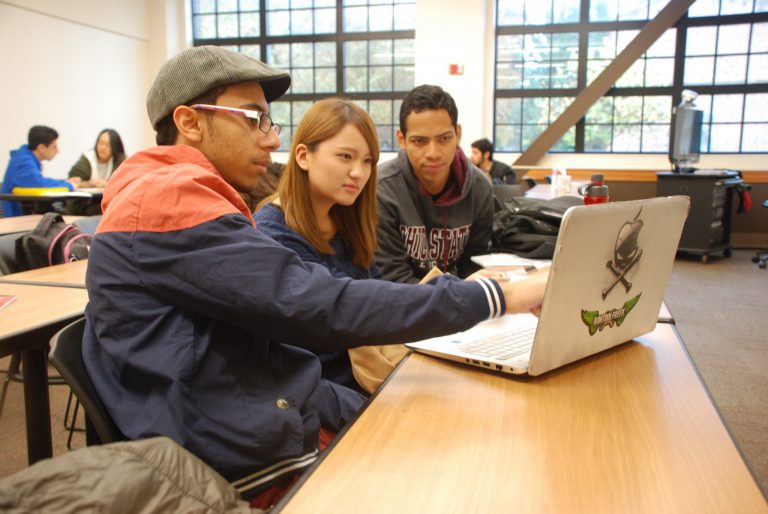
Over the past decade, there have been so many advancements in science, technology and medicine that it has been hard to keep track. These advancements are sure to continue over the next five years, but we will also start to rethink a lot about education; from the influence of electronics to the true value of a degree.
By the year 2020, we will see big changes in both learners and learning environments. With omnipresent internet access in most countries, young people across the world have access to a near infinite amount of free learning materials. Degree programmes are gradually becoming more learner-centric, and educators are benefiting from improved working conditions and career opportunities.
With innovation and technology becoming an increasingly integral part of the overall learning experience, what can we predict for the future of the classroom?
Rising college application will have some big impacts on the class of 2020: http://t.co/HmhnJU9LA3 #BestColleges
— U.S. News Education (@USNewsEducation) October 12, 2015
1. Educational change will predominantly be driven by people, not technology.
The general consensus on technological disruption says that existing models of higher education are broken. Technology drives change, and there is nothing educational institutions can do to stop it; therefore, they must embrace change, or risk becoming obsolete.
But according to the Horizon Scanning Report for the International Unit and Leadership Foundation for Higher Education, change is driven by people, institutions and countries with genuine political and economic interests, and the way universities have reacted to widespread distance learning and online courses is certainly evidence of this. It is, in fact, university faculty and experienced academics who now tell politicians that they must stop and think.
The report states that the impact of online learning on university business models and pedagogy will continue to be profound, but will manifest as an evolutionary shift as opposed to an avalanche of change.
By 2020, 70% of jobs will require education beyond high school, compared with 28% in the 70s. #olc15 #olctoday
— Micaela L. Seals (@micaelaseals) October 14, 2015
2. Students will begin to interact remotely.
In the fast-paced face of change, the question many learners are asking is: Why do so many classrooms look practically identical to those of thirty years ago?
Joe Williams, Executive Director of Democrats for Education Reform says: “With some exciting exceptions, public schools are one of the few institutions in modern life that have not seen radical changes spurred by technology.
“I’m not talking about having computers in classrooms, but rather a lack of any seismic shift in the way things are done because technology is making the work easier or more efficient.”
Williams predicts that technology in education will continue to push towards individualised instruction for students, and Hadley Ferguson, Director of the Edcamp Foundation, agrees. She says learners can “reach out beyond the walls of their classrooms to interact with other students, other teachers, and renowned authors, scientists and experts to enhance their learning.”
Some of these digitally-competent learners may go on to become teachers themselves, continuing to utilise, enhance and build upon their community of online learning.
By the end of 2020, 3 billion people will have access to Internet through mobile devices in the developing world. http://t.co/boSBYFtoho
— Level 3 (@Level3) October 14, 2015
3. Students have a voice- and it will be heard.
When the Cofounder of Revolution Foods, Kirsten Saenz Tobey, sat down in a school cafeteria and asked the students how they felt about their everyday meal options, one student responded: “Does this look like it was prepared by someone who respects me?”
Tobey points out that the students are essentially her customers, and if they don’t feel valued or that their voice is being heard, they will never buy into the healthier options her company supplies. Revolution Foods have even launched an app, Daily Bite, allowing the students to learn about health and nutrition, view the daily menu, as well as provide feedback on the food that they’ve been served.
Tobey states that engaging and respecting students and their families as partners will become a new focus in ways that we have never seen before: “Traditional education is very top-down, heavy-handed- sit down and read, be quiet, don’t ask questions- there’s still a lot of room for innovation.”
Once students start to feel truly valued, they will work in partnership with education institutions, improving working environments and conditions along with the overall learning experience.
Classroom of 2020: The future is very different than you…interesting article recommended by @TeacherKateRyck …http://t.co/i8KNETJGCM
— Sandy Doyle (@psmdoyle) October 14, 2015
4. People will start to think differently about the value of a Degree.
Jake Schwartz, CEO and Cofounder of General Assembly, claims that the pressure to keep tuition fees low, paired with an increasing population living with crippling debt, threatens the sustainability of institutions that are dependent on tuition.
“This will help to force an innovation drive with an unbundling of degree offerings,” he says. “The sector will see a shift towards more relevant competency-based programs and aggressive competition for students.”
The ever-expanding gap between education and employment will force innovation and creativity upon HE institutions, as they will need to consider how to offer attractive training to students for a workforce that desperately needs them.
Shannnon May, Cofounder of Bridge International Academies, agrees: “Today, diplomas granted by years in school are the dominant certification of ‘learning’. Yet, in almost all cases, these diplomas certify nothing other than the fact that the person in question spent x years in school.
“Competency-based certifications testing specific skills, and bundling individual skills into professional groupings will become a global currency for both employers and job seekers.”
By 2020, 65% of jobs will require postsecondary education. Money for college: http://t.co/nh31IYU3mM #NACAC15 pic.twitter.com/K8bhdE2hmw
— Cindy Forbes Cameron (@CForbesCameron) September 30, 2015
5. Higher Education will continue to gradually globalise.
Many predict that while their shares of the global student market may continue to decrease, the demand for qualifications from the main higher education exporting nations will remain steady. If this is to be the case, many wonder why so many institutions from these countries are slipping in the World University Rankings, but the fact that more and more universities in regions such as Asia are making their way into the World’s Top 200 does not mean the others are getting worse, but rather that institutions, globally, are gradually getting better.
By the year 2100, more than 50 per cent of the world’s population will live in India, China or Africa. “Global policy leadership and sales of education goods and services will be shaped less by issues and needs in the U.S, and more by the issues and needs of Africa, South Asia, and China,” May says, “Market demand, and pressing policy issues related to urbanisation and population growth, will shift the centre of gravity of education provision.”
There are two reasons why the international growth in student mobility will not maintain pace with the worldwide demand for higher education: the increase of domestic HE capacity in some countries, and the increase of transnational education (TNE) in others- including online education. The provision of TNE is likely to grow much faster than the rate of student mobility.
Jake Schwartz concludes, “For schools of all types, content or curriculum will not be the core differentiator, but rather they will be judged on how well they coordinate complex offerings into a useful package for their students and graduates.”
#Indian govt aims to increase #highereducation participation to 30% by 2020 http://t.co/7OrWiLLGlX #Indianstudents #colleges #unis
— Jacqueline Kassteen (@JKassteen) October 14, 2015
Liked this? Then you’ll love these…
Britain Plans Tougher English Tests to Cut International Student Numbers
USA Changes Law Damaging Prospects of International STEM Students







